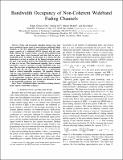| dc.contributor.author | Gomez-Cuba, Felipe | |
| dc.contributor.author | Erkip, Elza | |
| dc.contributor.author | Du, Jinfeng | |
| dc.contributor.author | Medard, Muriel | |
| dc.date.accessioned | 2017-10-04T16:08:02Z | |
| dc.date.available | 2017-10-04T16:08:02Z | |
| dc.date.issued | 2015-10 | |
| dc.identifier.isbn | 978-1-4673-7704-1 | |
| dc.identifier.issn | 2157-8095 | |
| dc.identifier.issn | 2157-8117 | |
| dc.identifier.uri | http://hdl.handle.net/1721.1/111786 | |
| dc.description.abstract | Peaky and non-peaky signaling schemes have long been considered species apart in non-coherent wideband fading channels, as the first approaches asymptotically the linear-in-power capacity of a wideband AWGN channel with the same SNR, whereas the second reaches a nearly power-limited peak rate at some finite critical bandwidth and then falls to zero as bandwidth grows to infinity. In this paper it is shown that this distinction is in fact an artifact of the limited attention paid in the past to the product between the bandwidth and the fraction of time it is in use. This fundamental quantity, that is termed bandwidth occupancy, measures average bandwidth usage over time. The two types of signaling in the literature are harmonized to show that, for any type of signals, there is a fundamental limit-a critical bandwidth occupancy. All signaling schemes with the same bandwidth occupancy approach the capacity of wideband AWGN channels with the same asymptotic behavior as the bandwidth occupancy grows to its critical value. For a bandwidth occupancy above the critical, rate decreases to zero as the bandwidth occupancy goes to infinity. | en_US |
| dc.language.iso | en_US | |
| dc.publisher | Institute of Electrical and Electronics Engineers (IEEE) | en_US |
| dc.relation.isversionof | http://dx.doi.org/10.1109/ISIT.2015.7282876 | en_US |
| dc.rights | Creative Commons Attribution-Noncommercial-Share Alike | en_US |
| dc.rights.uri | http://creativecommons.org/licenses/by-nc-sa/4.0/ | en_US |
| dc.source | MIT Web Domain | en_US |
| dc.title | Bandwidth occupancy of non-coherent wideband fading channels | en_US |
| dc.type | Article | en_US |
| dc.identifier.citation | Gomez-Cuba, Felipe et al. “Bandwidth Occupancy of Non-Coherent Wideband Fading Channels.” 2015 IEEE International Symposium on Information Theory (ISIT), June 14-19 2015, Hong Kong, China, Institute of Electrical and Electronics Engineers (IEEE), October 2015: 2351-2355 © 2015 Institute of Electrical and Electronics Engineers (IEEE) | en_US |
| dc.contributor.department | Massachusetts Institute of Technology. Department of Electrical Engineering and Computer Science | en_US |
| dc.contributor.department | Massachusetts Institute of Technology. Research Laboratory of Electronics | en_US |
| dc.contributor.mitauthor | Du, Jinfeng | |
| dc.contributor.mitauthor | Medard, Muriel | |
| dc.relation.journal | 2015 IEEE International Symposium on Information Theory (ISIT) | en_US |
| dc.eprint.version | Author's final manuscript | en_US |
| dc.type.uri | http://purl.org/eprint/type/ConferencePaper | en_US |
| eprint.status | http://purl.org/eprint/status/NonPeerReviewed | en_US |
| dspace.orderedauthors | Gomez-Cuba, Felipe; Du, Jinfeng; Medard, Muriel; Erkip, Elza | en_US |
| dspace.embargo.terms | N | en_US |
| dc.identifier.orcid | https://orcid.org/0000-0002-9709-0713 | |
| dc.identifier.orcid | https://orcid.org/0000-0003-4059-407X | |
| mit.license | OPEN_ACCESS_POLICY | en_US |
| mit.metadata.status | Complete | |
